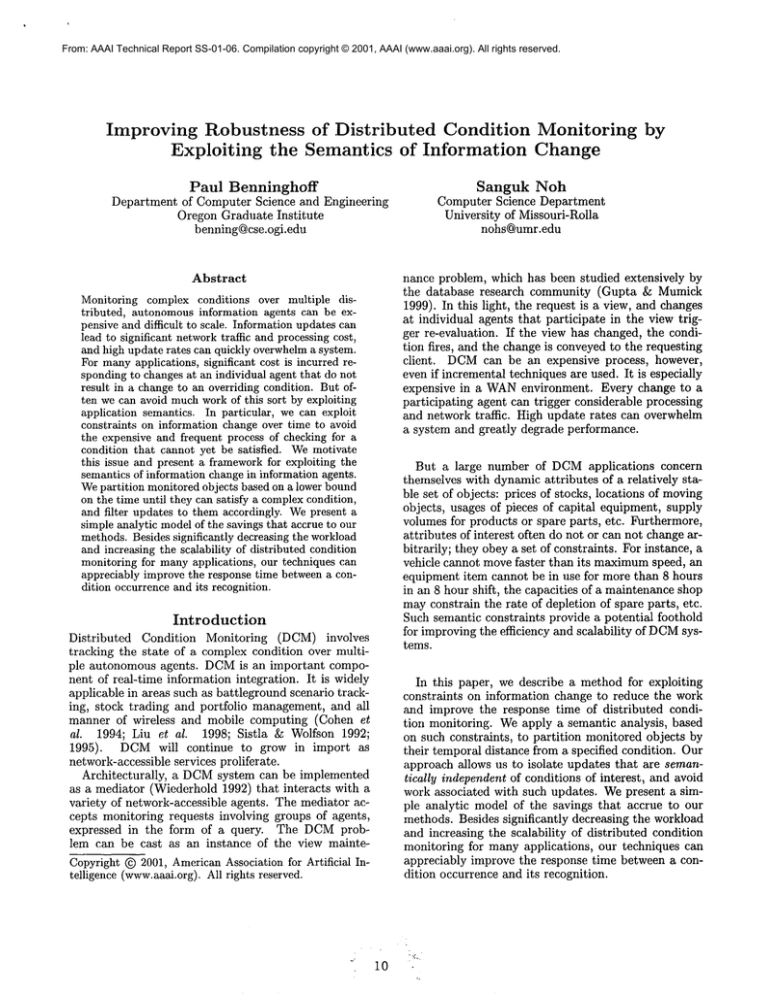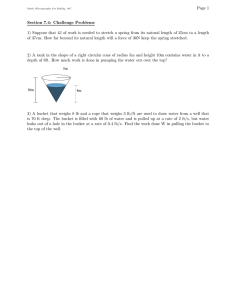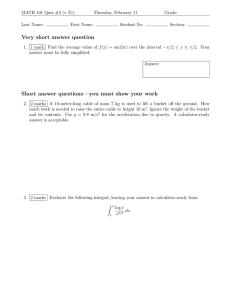
From: AAAI Technical Report SS-01-06. Compilation copyright © 2001, AAAI (www.aaai.org). All rights reserved.
Improving Robustness of Distributed
Condition
Exploiting the Semantics of Information
Paul Benninghoff
Department of Computer Science and Engineering
Oregon Graduate Institute
benning@cse.ogi.edu
Abstract
Monitoring complex conditions over multiple distributed, autonomousinformation agents can be expensive and difficult to scale. Informationupdates can
lead to significant networktraffic and processingcost,
and high update rates can quickly overwhelma system.
For manyapplications, significant cost is incurred respondingto changes at an individual agent that do not
result in a change to an overriding condition. But often we can avoid muchwork of this sort by exploiting
application semantics. In particular, we can exploit
constraints on information change over time to avoid
the expensive and frequent process of checking for a
condition that cannot yet be satisfied. Wemotivate
this issue and present a frameworkfor exploiting the
semantics of information change in information agents.
Wepartition monitoredobjects based on a lower bound
on the time until they can satisfy a complexcondition,
and filter updates to them accordingly. Wepresent a
simple analytic modelof the savings that accrue to our
methods.Besides significantly decreasing the workload
and increasing the scalability of distributed condition
monitoring for manyapplications, our techniques can
appreciably improve the response time between a condition occurrenceand its recognition.
Introduction
Distributed
Condition Monitoring (DCM) involves
tracking the state of a complex condition over multiple autonomous agents. DCMis an important component of real-time information integration. It is widely
applicable in areas such as battleground scenario tracking, stock trading and portfolio management, and all
manner of wireless and mobile computing (Cohen et
al. 1994; Liuet al. 1998; Sistla &~ Wolfson 1992;
1995). DCMwill continue to grow in import as
network-accessible services proliferate.
Architecturally,
a DCMsystem can be implemented
as a mediator (Wiederhold 1992) that interacts with
variety of network-accessible agents. The mediator accepts monitoring requests involving groups of agents,
expressed in the form of a query. The DCMproblem can be cast as an instance of the view mainteCopyright (D 2001, AmericanAssociation for Artificial Intelligence (www.aaai.org).All rights reserved.
Monitoring
Change
by
Sanguk
Noh
Computer Science Department
University of Missouri-Rolla
nohs@umr.edu
nance problem, which has been studied extensively by
the database research community (Gupta & Mumick
1999). In this light, the request is a view, and changes
at individual agents that participate in the view trigger re-evaluation. If the view has changed, the condition fires, and the change is conveyed to the requesting
client. DCMcan be an expensive process, however,
even if incremental techniques are used. It is especially
expensive in a WANenvironment. Every change to a
participating agent can trigger considerable processing
and network traffic.
High update rates can overwhelm
a system and greatly degrade performance.
But a large number of DCMapplications
concern
themselves with dynamicattributes of a relatively stable set of objects: prices of stocks, locations of moving
objects, usages of pieces of capital equipment, supply
volumes for products or spare parts, etc. Furthermore,
attributes of interest often do not or can not change arbitrarily; they obey a set of constraints. For instance, a
vehicle cannot move faster than its maximumspeed, an
equipment item cannot be in use for more than 8 hours
in an 8 hour shift, the capacities of a maintenance shop
mayconstrain the rate of depletion of spare parts, etc.
Such semantic constraints provide a potential foothold
for improving the efficiency and scalability of DCM
systems.
In this paper, we describe a method for exploiting
constraints on information change to reduce the work
and improve the response time of distributed condition monitoring. Weapply a semantic analysis, based
on such constraints, to partition monitored objects by
their temporal distance from a specified condition. Our
approach allows us to isolate updates that are semantically independent of conditions of interest, and avoid
work associated with such updates. Wepresent a simple analytic model of the savings that accrue to our
methods. Besides significantly decreasing the workload
and increasing the scalability of distributed condition
monitoring for many applications, our techniques can
appreciably improve the response time between a condition occurrence and its recognition.
Partitioning
Objects
by "MinTTI"
Our approach applies to distributed conditions that involve tracking attributes of a set of objects whoserate
of change is constrained. Weare given a monitoring
request expressed as a distributed query over a collection of information agents, and one or more integrity
constraints that apply to attributes in the request. We
assume a baseline monitoring interval, M0, for the request. Wegenerate a companion query that, for each
object, computes a lower-bound on the time before object changes can satisfy the distributed condition of interest. If we call the original request Q, then we refer to
the companion query as the MinimumTime ’Til Interesting with respect to Q, or M±nTTIQ.
Wepartition the
set of monitored objects into buckets based on their
MinTTIQvalues, and track changes to each bucket at
the largest possible time interval that is less than the
least MinTTIQvalue for the bucket. A snapshot of this
process is depicted in Figure 1.
B
0
B
2
Figure 2: A battlefield
enemy units.
O0 O
O0O0O O0 O0 OI
°°o
eOoO
OoO:O
*oO.OI
DO g
.-.....
oOoOo
Mo
/ Zone
M1
zone. This condition can be expressed as the following
query, expressed in datalog notation (Ullman 1988):
¯ Threaten(UnitID, LZ)
LandingZone(LZ, Loc0) A EnemyUnit(UnitID)
UnitType(UnitID, Type) A WeaponRange(Type,
A Position(UnitID, Locl) A Distance(Loc0, Locl,
AD<R.
oo-oOp
M2
Note that the key changeable attribute in this request is the location of enemyunits. Adds and deletes
can happen in other predicates (e.g., LandingZone or
EnemyUnit), but the most frequent updates will be
modifications of the location attribute in Position. But
a unit’s position cannot change arbitrarily. In particular, suppose we are given the following constraint:
Ms "’
Time
Figure 1: Partitioning
’Til Interesting.
scene with a landing zone and
objects based on MinimumTime
¯ :- upd(Position(UnitID, (Loc0,Locl)), T) A
Type(UnitID,
Type) A MaxSpeed(Type, MPH)
Distance(Loc0, Locl, D) A D > MPH×
A Motivational
Example
Consider a (slightly simplified) example distributed
condition that arises in DARPA’s"CommandPost of
the Future" project. Wehave an information agent that
provides sensor data on the movementsof enemy units
over a far-reaching battle area. Another information
source provides the location of landing zones where helicopters can land to transport personnel and material
in and out of the area. Other agents provide information on types of enemy units and the ranges of weapons
associated with the units by type. A geocoder agent is
able to computedistances between entities based on the
"latlong" coordinates provided by the location sensors.
A snippet of the battleground is depicted in Figure 2.
A commanderin the field wants to be notified whenever an enemy unit "threatens" a landing zone, meaning
whenever a unit comes within its weapon’s range of the
This constraint is headless, meaning it derives false.
It is interpreted as follows: If Position(UnitlD, LocO)
is true at time 0, and Position(UnitlD,Locl) is true
at time T, then the distance between LocO and Locl
cannot be greater than the product of the maximum
speed of UnitlD, MPH,and the time transpired,
T.
Note that this constraint incorporates information from
multiple agents, and it makes use of supplemental information, namely the MaxSpeedpredicate, that is not
part of the original request.
Based on this constraint, we can write the following
definition for MinTTIThreaten:
¯ I~inTTIwhreate~(UnitID,T)
LandingZone(LZ, Loc0) A EnemyUnit(UnitID)
UnitType(UnitID, Type) A WeaponRange(Type,
11
5. Bucket triggers can be created and modified atomically.
By implementing bucket triggers at the individual
agent, irrelevant updates are filtered away as early as
possible. The mediator never sees them.
The intuition behind our approach is straightforward.
If an object is far from satisfying a condition of interest,
we can ignore changes to it for a while. In our example, if we are concerned with enemyunits that threaten
a given landing zone, we needn’t repeatedly compute
the Threaten predicate in response to the movement
of tanks, say, that are hundreds of miles away. By ignoring such changes, we avoid the expensive process of
evaluating a complex, distributed condition for every
change. The price of our scheme, however, is the need
to do bucket maintenance. We now look more closely
at the costs and benefits of our approach.
A Position(UnitID, Locl) A Distance(Loc0, Locl,
A D > R A MaxSpeed(Type,
MPH) A T = (DR)/MPH.
Note that we will take the minimumT value for each
UnitlD. In general, since we are computing a lowerbound time, we always take the minimumtime grouped
by the object identifier for MinTTI.Note, further, that
the definition of MinTTIThre~tenhas a high degree of
commonality with the Threaten predicate itself. Such
commonality implies that whenever Threaten must be
computed, MinTTIThre~ten can be computed as well at
little additional cost. This pattern of commonalitybetween a condition and its HinTTIquery is typical.
Partitioning
Pragmatics
Automatic generation of MinTTIis an important aspect
of our research, but it is beyond the scope of this paper. In fact, for an important class of requests and
constraints, we can employ a combination of semantic
query optimization techniques (Chakravarthy, Grant,
Minker 1990) and other simple program transformations to automatically generate MinTTI.Weplan to describe this process in a forthcoming paper. In the absence of automatic generation, however, it is perfectly
reasonable to write MinTTIdirectly by hand. The system can then use the definition to optimize the monitoring process.
Given the definition of MinTTI, we compute a relation of Of D-Time pairs that covers every object currently being monitored at a particular source. This relation provides the basis for dividing monitored objects
into buckets. In general, there is always an "urgent
bucket", which we monitor at the baseline interval (often as quickly as possible). An important issue is how
many additional buckets we have, and how the bucket
boundaries are defined. An extreme approach is to have
a separate bucket for each object. The other extreme is
to place all the objects in a single (urgent) bucket.
will describe an approach based on two buckets. But we
believe a clustering approach, where a natural partition
emerges from the data, is promising.
Another important issue is how buckets are implemented. There are a number of options, but we prescribe an agent "bucket-trigger" capability that operates (modulo several minor variations) as follows:
Modeling Monitoring Costs
Given a query Q that describes a complex distributed
condition involving dynamic attributes of a set of N
objects, S, with monitoring interval M, the naive approach to monitoring Q with respect to S is as follows:
1. At the source of S, at each monitoring interval, check
if there is a change to S.
2. If there is a change, call it /kS, send /kS to the mediator.
3. At the mediator, compute AQwith respect to AS.
Weassume that the cost of local monitoring (Step
1) is relatively small, and that, in any case, it doesn’t
vary enough in the approaches we compare to be of
consequence. Wewill consider the cost of sending AS
to the mediator as part of the cost of computing AQ,
and that cost is given by the cost function of the query
optimizer. Weassume the statistical
properties of AS
follow those of S, with the exception of its cardinality
(denoted as IASI). Hence the cost of computing/kQ is
a function of IASI, and the expected cost of the naive
approach is given by:
N
E(Cost,~aive)
~- ~p(IAS[ = x) x C (AQ, x)/ (1)
x~-O
where p(IASI = x) is the probability of I/kS] = x, and
C(/kQ, x) is the cost, given by the cost function, of the
query/kQ with respect to AS, with IASI -- x. Note
that the cost is expressed per unit time.
For our bucketing approach the expected cost is the
sum of the expected costs of each bucket. For L buckets,
the cost is given by:
1. A group of object ids is associated with each bucket
in the bucket-trigger.
2. A "change bucket" table is maintained for each
bucket, with an associated monitoring interval.
3. As object attributes change, the change is recorded in
the appropriate change bucket. If a value is already
present for the given OID, it is overwritten.
L-1
E(Costb~cko,s)
= ~ E(CostB,)
4. A daemon process empties each change bucket at the
appropriate interval, and passes the contents to the
client of the trigger (the mediator, in our DCMarchitecture).
(2)
i-=O
Bo is distinguished as the urgent bucket. The processing related to this bucket is similar to that of the
12
naive approach, except we have the additional process
of bucket maintenance to worry about. That is, a
change to an object in B0 may result in a change to
Q, and it may also result in a change to the MinTTIq
value associated with that object, which in turn may
result in a bucket change for that object. The steps
associated with B0 are as follows:
1. At the source of S, at each monitoring interval, check
if there is a change to the membersof S in Bo.
2. If there is such a change, call it AB0, send ABoto
the mediator.
3. At the mediator, compute AQ and perform bucket
maintenance with respect to AB0.
Assumethat we use a partitioning strategy where the
dividing points between buckets, once established, are
fixed. Then the cost of bucket maintenance is dominated by the cost of computing a new MinTTIQfor each
object in ABo.1 By a similar argument to that of the
naive case above, the expected cost of the urgent bucket
is given by:
No
E(CostBo)
F,p(l 8ol =x)
x:O
C(AQ -F AMinTTIQ,x)/Mo
(a)
where C(AQ + AMinTTIQ,x) is the cost, given by the
cost function, of executing the two queries AQ and
AMinTTIQwith respect to ABo, with [ABol = x. Note
that M0, the monitoring interval for the urgent bucket,
is the user-defined monitoring interval, which is the
same Mthat applies to the naive case (Equation 1).
No is the number of objects in Bo, which is less than
N.
Nowconsider the non-urgent buckets, Bi,i > 0. Recall that the MinTTIQvalue for any object in a nonurgent bucket is greater than the monitoring interval
for that bucket, Mi. Thus, by definition, a tuple in
ABi, i > 0, cannot result in a change to Q. Therefore
the computation of AQis not needed for the non-urgent
buckets; only bucket maintenance is required. The expected cost for each non-urgent bucket, then, is given
by:
E(Costs,)
p(J BI = x)
p(lASI: x) b(x; N,t~)
p(lAY01
= x) b(x; No, 0)
(4)
1This is conservative in that bucket maintenancemaybe
donemoreefficiently in somecases. It is generousin that we
disregard the cost of notifying the remotesource of bucket
changes.
(5)
(6)
where b(x;n’O) = ( Ox(1-O)n-~ is thexth bin°
mial coefficient.
For the non-urgent buckets, Bs, i > 0, Ms > M, and
thus 0s > 0. Assumethat Ms = ks x Mfor some integer
ki. Then the probability of x changes to a single object
within Mi is b(x; ks, 0), and 0s, the probability of some
change to a single object within Ms, is 1 - b(0; k~, 0)
1 - (1 - 0) k’ . Thus the distribution of IABsl is given
by:
p([ABsl=x)
= b(x;Ns,
l-(1-O)
for i = 1,...,(L-
k’)
(7)
1)
Notice that if we monitored the objects in Bs at interval M, as we would in the naive case, we would expect to process OksNs updates to these objects every
Ms time period. With bucketing we expect to process
(1 - (1 - O)k~)Ni updates in the same period. That is,
the expected volume of Meaningless Updates Discarded
(MUD)for Bs is given by:
E(MUDB~)= OksNs (1 - ( 1 O)k’)
(8)
MUD,and the avoidance of related processing costs,
is the source of the savings produced by the bucketing
approach. Whenthese savings exceed the overheads introduced by bucket maintenance, our approach is beneficial.
Performance Assessment:
x=O
C(AMinTTIQ, x)/Mi
for i= 1,...,L-1
Cardinalities
of Deltas
The equations we have derived thus far depend on
the distribution of the cardinalities of the deltas, IASI
and lABel. To model these distributions,
assume that
changes to objects in S are independent, and that the
probability of an object changing in a given time interval is independent of and identical to the probability of
=
it changing in any other time interval of equal length.
This implies that the number of changed objects for
a given set of objects within a given monitoring interval, and thus the cardinalities of the deltas, follows a
binomial distribution. Suppose, further, that the probability that a given object will change in the smallest
monitoring interval, M, is 0. The distributions for IASI
and IABol are given by:
2-Bucket
Case
Wenow consider the simplest possible implementation
of our methods: two buckets (L = 2), B0 and B1, with
a fixed boundary between them, M1. Assume, without
2This assumption is imperfect, but not damaging.Trying
to modelcomplexinter-update correlations is difficult at
best, and we postulate that our methodstend to workbetter
wheresuch correlations exist.
13
loss of generality, that M= M0= 1. Then M1 = kl.
For simplicity of analysis, we will also assume simple
3linear forms for the query cost functions as follows:
C(AQ, x) =
C(AMinTTIQ,
x) -~ Bx
C(AQ + AMinTTIQ,x) = (A + B)x
E(Cost2-bucket~)
Finally,
M1 = ~/BR/(A + B)O
(13)
Table 1 and Table 2 show analytical results for a
range of values of R and 0 in the pessimistic model and
the optimistic model, respectively. Here we assume that
there are 10,000 objects to be monitored (N -- 10,000).
Weshow cost comparisons for the pessimistic assumption that C(AQ+AMinTTIQ, x) = (A+ B)x = 2Ax, and
the optimistic assumption that C(AQ+AMinTTIQ,
x)
Ax. In this setting, the objects are monitored over the
values, R, ranging from 100 to 10,000. The probability
that a given object will change in a specific monitoring
interval, 8, varies between 0.01 and 0.25. Wecompute
M1, Cnaive, and Cbuckets
using Equation 13, 11, and
12, respectively. In each table, the Gain is the difference between the cost of the bucketing approach and
that of the naive approach.
(9)
Note that Equation 9 represents a worst case cost
for computing AQand AMinTTIQtogether. But if Q
and MinTTIQare highly similar, as will often be the
case, we can do much better. Multiple-query optimization techniques (Sellis 1988) may enable us to compute
AMinTTIQ
for very little additional cost, in which case:
C(AQ + AMinTTIQ,x) ~ Ax
= ((M1/R) x N x ~ x (A +
((1 M1/R) x N x B)/M1 (1 2)
E(Cost2-b~kets) is minimized by choosing:
(10)
In any event, the cost of the naive monitoring implementation is given by:
N
E(Cost, o vc) b (x;N,e)
x=O
=
~×N×A
Table 1: Cost comparisons for the pessimistic model
(11)
[]
Wenow consider how a choice of/141 can be made to
minimize the cost of the 2-bucket approach, and compare this cost to the naive approach. Suppose we have
a stable uniform distribution of MinTTIQ
values for the
set of objects, S, over the range [0..R]. Given M1,
No = (M1/R) × an d N1 = ( 1 - M1/ R) x N . The
cost of the 2-bucket approach in this case is given by:
E( Cost2-b~ckets )
(M1/R)N
R[ O[ M1 [[ Cnaive [
71
100 0.01
100A
i00 0.05
32
500A
100 0.25
14 2500A
1,000 0.01 224
100A
1,000 0.05 100
500A
1,000 0.25 45
2500A
100A
10,000 0.01 707
10,000 0.05 316
500A
10,000 0.25 141 2500A
Cbuckets
182.8A
532.5A
1314.3A
79.4A
190.0A
437.2A
27.3A
62.2A
140.4A
[ Gain [[
-82.8A
-32.5A
1185.7A
20.6A
310.0A
2062.8A
72.7A
437.8A
2359.6A
(M1/n)N,
e) × C(Q+ MinTTIQ,
x~O
(I--MI/R)N
Table 2: Cost comparisons for the optimistic model
b(x; (1 - M1/R)N, 1 - (1 - e) (1-M1/n)N) ×
x=O
[[
C(AMinTTIQ,x)/M1
= ((M1/R) x N x O x (A + B))
((1 M1/R) × N x (1- ( 1 O)( 1- MI/n)N) × B)/ M1
As a final simplification, for the sake of exposition,
assume the probability that an object in Bz will change
within MI is 1. That is, we will round ~1 = 1 - (1
O)(1-M1/n)N to 1 in the above equation. Note that
while 01 approaches 1 as 0 goes to 1 and as M1gets
large, this is an overestimate of the costs associated with
B1. But it allows us to simplify the above equation to:
R[ O[ M1 [] Cn~i~ [Cbuckets
]
100 0.01
100
100A
100.0A
i00 0.05
45
500A
347.2A
100 0.25
2O 2500A
900.0A
316
100A
1,000 0.01
53.2A
1,000 0.05
141
500A
131.4A
1,000 0.25
63
2500A
306.2A
10,000 0.01 1000
100A
19.0A
447
500A
43.7A
10,000 0.05
10,000 0.25
200 2500A
99.0A
Gain
[]
0
152.8A
1600.0A
46.8A
368.6A
2193.8A
81.0A
456.3A
2401.0A
In the pessimistic model, when R = 100 and ~ =
.01 and .05, our bucketing approach is worse than the
naive approach since the cost of bucket maintenance
aWechoose not to use the AX+ Y form since it does not
capture the important notion, in our setting, that X = 0
implies C -= 0.
14
outweighs the (relatively small) savings due to MUD.
In all other cases, however, under our assumptions, our
method provides a more efficient monitoring capability.
Conclusions
Wehave presented a framework for exploiting constraints on information change in Distributed Condition Monitoring. For a large class of applications, our
techniques can greatly reduce the update rate seen by
GainIn PesslmlsUc
Model
a DCMsystem, and thus improve the scalability
and
response time of such systems. These improvements
25oo
;.......................................................
...........
::,
............
should translate into greater robustness in the face of
update bursts (for example) as well.
There are several clear areas for near-term expansion
of
these ideas. Requiring the manual specification of
= 1500.I
==
MinTTI for each request in a DCMis burdensome and
-,l~-0.25
error-prone. Weare currently investigating techniques
,~ 1000-+- 0.05
-m 0.01
for automatically generating HinTTI. The issue of how
bucket boundaries are defined is important as well. We
500j
¯ i
intend to investigate a range of approaches for doing
/
:T
,--~,
.~
--: ,
this, including clustering techniques.
0
~
’
5000
10000
Interesting future avenues to pursue include trying to
J................................................................................................................
"500
broaden the range of constraints we can work with. OfRx 1000
ten absolute constraints do not exist, but probabilistic
ones do. A stock currently priced at $20, for example,
is highly unlikely to drop to $2 in a matter of hours (reFigure 3: The pessimistic cost savings.
cent events notwithstanding). Howcan constraints that
apply (merely) with high probability be integrated into
our scheme? What are the tradeoffs between efficiency
and scalability in applying these techniques, and accuGainIn OptimisticModel
racy or consistency (a familiar theme in Internet-based
systems)? Can reasoning about the intent of monitored
3000
1...........................................................................................................................objects be incorporated into our constraint reasoning as
well? Also, "time" can be more general than clock time.
Constraints might be based on some necessary path of
changes, required intermediate steps, or some discrete
2000
number of update events.
-,L--0,25
i lsoo [
In the Internet age, scalability and robustness are a
J-+-0.05
i-*-o.o,
constant challenge in computing. Webelieve semantics
provide a key source of traction in meeting this challenge. The ideas in this paper represent a first step
500 ~_
toward tapping this source in DCMsystems. Significant work in view maintenance has sought to determine
when updates are syntactically independent of views
0
5000
10O0O
(Levy & Sagiv 1993); the work we present here is the
Rx 1000
first attempt, to our knowledge, to isolate updates that
are semantically independent of views.
Figure 4: The optimistic cost savings.
Acknowledgments
Figures 3 and 4 depict the pessimistic and optimistic
We thank Dr. Dave Maier and Dr. Phil Cohen for
cost savings for a range of R values with 0 fixed at .01,
support and feedback on this work. Wegratefully ac.05, and .25. In both figures, as 0 increases, the cost
knowledge the support of the DARPACoABSProgram
savings of the bucketing approach increases as well. As
(contract F30602-98-2-0098, AOG352) for the research
object changes become more frequent, more MUDis
presented in this paper.
generated by our methods, which translates
to more
savings.
References
Note that in general we may, at best, only be able to
Chakravarthy, U. S.; Grant, J.; and Minker, J. 1990.
estimate (or guess) at 0. But simple calculations based
on the above show that even if we are wrong in our
Logic-based approach to semantic query optimization.
guesses, and our choice of M1is imperfect, we can still
1EEE Transactions on Database Systems 15(2):162do better than the naive approach.
207.
20007..............
i
I
[
iiooo
15
Cohen, P. R.; Cheyer, A.; Wang, M.; and Baeg, S. C.
1994. An open agent architecture.
In AAAI Spring
Symposium, 1-8. AAAIPress/MIT Press.
Gupta, A., and Mumick, I. S., eds. 1999. Materialized Views: Techniques, Implementations, and Applications. MITPress.
Levy, A. Y., and Sagiv, Y. 1993. Queries independent of updates. In Agrawal, R.; Baker, S.; and Bell,
D. A., eds., 19th International Conference on Very
Large Data Bases, August 2~-27, 1993, Dublin, Ireland, Proceedings, 171-181. Morgan Kaufmann.
Liu, L.; Pu, C.; Tang, W.; Buttler, D.; Biggs, J.; Benninghoff, P.; Hail, W.; and Yu, F. 1998. Cq: A personalized update monitoring toolkit. In Proceedings of
the ACM SIGMOD.
Sellis, T. K. 1988. Multiple-query optimization. IEEE
Transactions on Database Systems 13(1):23-52.
Sistla, P., and Wolfson, O. 1992. Triggers on database
histories. Data Engineering.
Sistla, P., and Wolfson, O. 1995. Temporal conditions
and integrity constraints in active database systems.
In Proceedings of International Conference on Management of Data. ACM-SIGMOD.
Ullman, J.D. 1988. Principles
of Database and
Knowledge-Base Systems, Volumes i and 2. Computer
Science Press.
Wiederhold, G. 1992. Mediators in the architecture of
future information systems. IEEE Computer 25(3):3849.
16




